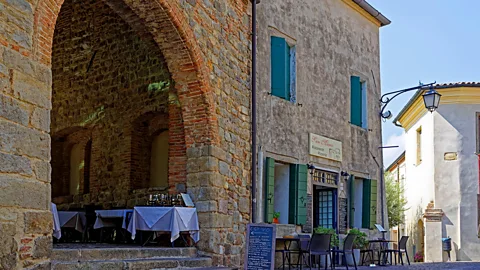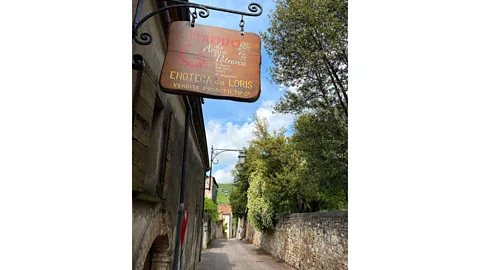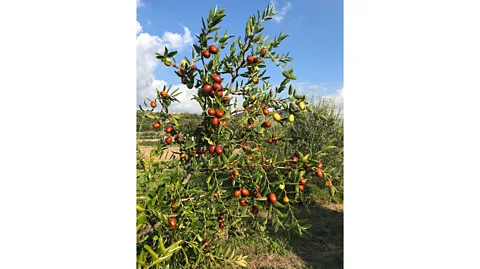The tiny Italian town that drinks like Ancient Rome and Greece
 Prisma by Dukas Presseagentur GmbH/Alamy
Prisma by Dukas Presseagentur GmbH/AlamyArquà Petrarca is known as the final resting place of a Renaissance patriarch – and the source of a fabled liquor whose name means "to live in bliss", made from the jujube fruit.
The year was 1370, and even the shimmering canals of Venice brought no joy to sco Petrarch. Over the last two decades, the world-renowned scholar and poet had travelled the length and breadth of Italy. But with every ing year, he found himself retreating more from social life, seeking to escape the "ignorance" of his age.
"I escape the city like an exile," he wrote, "and choose to live in a solitary small village, in a pretty little house… where I spend my days completely calm, away from the tumult, the noise, the chores, continuously reading and writing.
Travelling west from the Venetian coast in search of this elusive paradise, Petrarch would have seen the shapes of the Euganean Hills rising over the broad, flat plain of the Po River Valley like beacons. Nestled in the heart of them, he found his Eden: the tiny village of Arquà.
Arquà Petrarca, as it has since been renamed, is still a small town of barely 2,000 residents – a "soft, quiet hamlet… in the deep umbridge of a green hill's shade", to quote Lord Byron, who visited the town on the Grand Tour. Its medieval stone houses make a ramshackle ascent from the 11th-Century Church of Santa Maria Assunta, where Petrarch's tomb is proudly on display, to his frescoed villa that is surrounded by flowering fruit trees in spring.
Petrarch's house and tomb remain the main draw for this town, some 30km south of the university town of Padua, whose residents come to enjoy the landscape where Petrarch finally found peace. But locals here know that the landscape hides a second, lesser-known treasure that Petrarch no doubt would be fond of: the singularly wonderful giuggiole, or Italian jujube fruit.
Small, olive shaped or sometimes round, with a hard pit and a green and brown exterior, the jujube is a fruit of many flavours. Fresh, it tastes like a hard, woody apple – but ripened off the vine, it takes on a sweet, complex character that lends its flavour to a beloved local liquor: the brodo di giuggiole, or jujube broth.
Beloved by the elites of Petrarch's day, jujube brothwas once so famous that it gave birth to an idiom, first recorded in 1612: andare in brodo di giuggiole ("to go in jujube broth") – meaning to live in a state of bliss.
Today, though, after a long decline in jujube cultivation, this elusive liquor has been all but forgotten by most Italians – except the residents of this one, tiny hilltop town. Since the 1980s, a small group of entrepreneurs has since worked to remake the brodo di giuggiole as one of the world's most exclusive liquors and restore the jujube as the unforgettable flavour of Petrarch's favourite town.
 John Last
John LastOn a grey day in early November, I travelled to Monselice, a town just outside the valley where Arquà lies, to meet Alessandro Callegaro, heir to a small family farming business that is working to revive the ancient culinary heritage of Arquà and its fruits.
Callegaro's business, Scarpon, is known for its experimentation with unusual and long-forgotten flavours. Among his preparations are savoury sauces made from wild poppy greens; grape pudding produced in the manner of Venetian peasants; and extracts sourced from wormwood following a recipe used by Charlemagne.
"We are trying to help people experience the flavours of the past, although this isn't easy to do," he told me. He says the jujube has become "a forgotten fruit" – its liquor another ancient concoction in need of expert recovery.
The jujube tree was first brought to Italy in the reign of the first Roman emperor, Augustus, by soldiers returning from Syria. Legend has it that its thorny branches were the ones that formed the crown of Jesus Christ. For Romans, the tree was a symbol of silence and good fortune, used to adorn the temples of the goddess Prudentia.
 John Last
John Last"Even today, here, the plant is a good omen," Callegaro said. "Traditionally, farmers' houses had a jujube tree near the front door… for good luck."
In Arquà Petrarca, you can still find one or two trees outside "almost every house", the Italian scholar Cristina Bignami writes in a brief history of the town's love of the jujube. "Many specimens are centuries-old and large in size, and therefore play an important role on a landscape, historical and cultural level."
Callegaro's own house – a stone and stucco villa in the valley below Arqua's centre – has a jujube tree more than a century old just outside the door. It's just one of many ancient plants his grandfather and father saved when jujube trees were increasingly cut down to make way for more profitable olive groves.
After all, jujubes have always been challenging as a commercial proposition for farmers. With their thorny branches, they are difficult and time-consuming to harvest. They have a narrow season – just four to six weeks from September to October – a short shelf-life, and a lengthy process to extract their flavour. Historically, that has made scaling production impossible.
This fact has led to some experimentation with other, less ancient varieties that show potential for mass production. On a call from his garden in Verona, the agronomist Ferdinando Cossio showed me two meatier, easier-to-harvest cultivars he'd imported from China, where jujubes are frequently used to produce powders for cooking and medicine. "[These] two have the best quality, in my opinion," he told me. "Sweet, juicy, crunchy… everyone I give the fruit to, to taste, says it is better than any other."
But still, he said, it is difficult to compete with the familiar, traditional variety. "People enjoy the primordial taste," Cossio told me, "the taste of the fruit where you eat one [and] you are a baby, a boy, again."
It's that elusive taste Callegaro has tried to capture with his "brodo di Arquà", his attempt to recreate the infamous brodo di giuggiole that once stole the hearts of Renaissance drinkers.
 Hilke Maunder/Alamy
Hilke Maunder/AlamyThe earliest recipe for the concoction dates to the 16th Century, developed by the powerful Gonzaga family, who served it at lavish feasts on their estate at Lake Garda. But it's quite possible such preparations are even older – some believe it could have been jujube liquor that waylaid Odysseus on the Isle of Lotus-Eaters in Homer's ancient epic. Similar concoctions of seasonal fruit like quince and fig, boiled down and mixed with grape must, were known as defrutum or caroenum in Ancient Rome and can be found in early Roman cookbooks, according to food historian Sally Grainger.
In making his own brew, Callegaro's family spent "four or five years" testing variations on traditional peasant recipes. "Jujube broth was typically not made to be sold," he said, "so each farming family added something of their own. We took these recipes, cleaned them up a bit, and tested, until we got to what we liked."
Scarpon's recipe is, like all jujube broths, a mix of seasonal fruits: quince, pomegranate and grape all feature prominently. But Callegaro tries to keep jujubes as the dominant flavour – ideally 30-35% of the final mixture.
 REDA &CO srl/Alamy
REDA &CO srl/AlamyThe result is a bouquet of caramelly autumn flavours with the light acidity of summer citrus. Served over ice or with a splash of prosecco in "spritz Euganei", it makes for a surprisingly refreshing drink.
But you are unlikely to see Scarpon's brodo in your local liquor store. Callegaro produces just 8,000 bottles a year. Like many in Arquà's culinary scene, he sees virtue in keeping his business as artisanal as possible.
Driving up one of the leafy hills that overlook Arquà's medieval centre, Callegaro took me to visit some friends and fellow lovers of the jujube: the Borin family, owners of the glamorous and palatial Ristorante La Montanella. Founded as a humble osteria (traditionally, a place serving wine and simple food) in 1952, before electric lights had made it to the village, it moved to its new, grand location in the 1960s and has become one of the community's oldest and most respected restaurants.
"A poet once wrote that God emptied Noah's ark in our territory," said Giorgio Borin, the second-generation owner of the restaurant. "Meat, fish, vegetables from the mountains, the hills, the plains, lakes, the river… There is everything."
Borin's menu is a reflection of this, and of the region's longstanding love of wild game: risotto with quail; homemade pappardelle with roe deer ragu; duck with caramelised apple and grapes, inspired by a recipe from the 16th Century. But the newest addition, conceived by Borin's daughter, is a take on the iconic Italian Christmas cake, panettone, flavoured with jujube pulp taken from Callegaro's harvest. They call it giuggiolone (a play on panettone).
 John Last
John LastBorin explained that Arquà's jujube obsession has always been an intentional development, an effort to highlight one local delicacy as a symbol of the community and a draw to the town. When the search began in the 1970s, those looking around their community knew the choice seemed obvious: the jujubes hanging in virtually every garden.
Since 1981, the town has celebrated this heritage with an annual jujube festival at harvest time – a chance for many producers to highlight their products and share their limited supply with visitors from out of town.
Borin says this only works if jujube growers stick to their local, artisanal roots. The scarcity of their products means their practice remains sustainable and rooted in tradition – and ensures that those who wish to taste the jujube's indescribable flavour must make their pilgrimage to Petrarch's town to get their own taste of bliss.
"We could make the jujube an industry," he said. "But to make it an industry is to lose its uniqueness… To be an artisan is to be limited."
At this, his daughter, sca, cut in. "It's not a limit – it's a choice."
BBC.com's World's Table "smashes the kitchen ceiling" by changing the way the world thinks about food, through the past, present and future.
---
